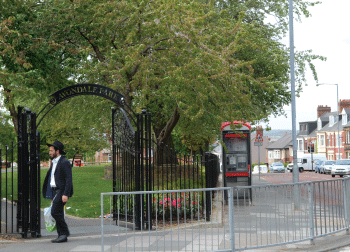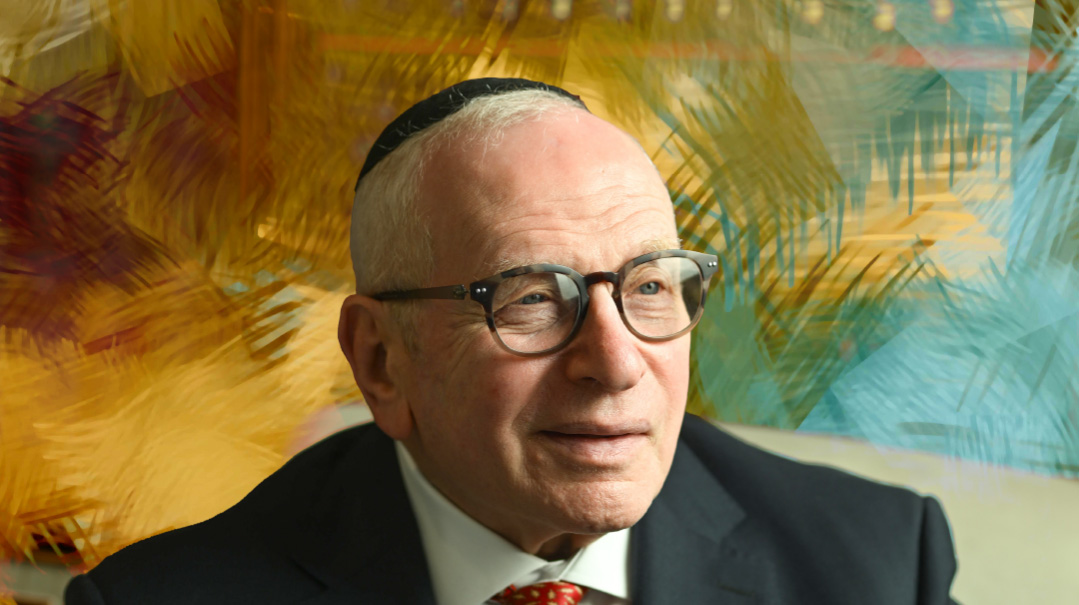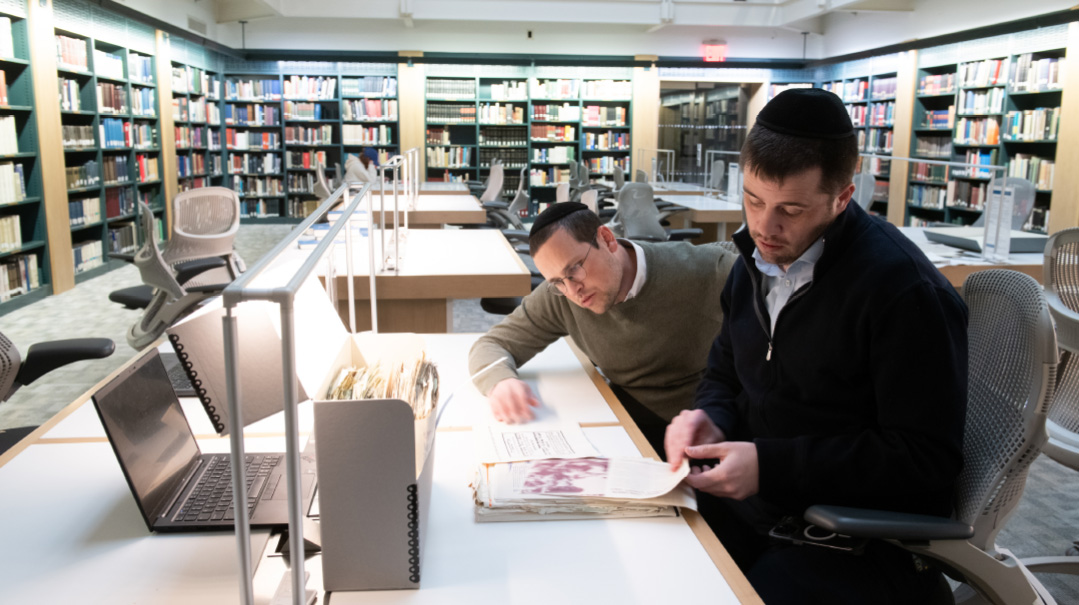Gateshead’s Twenty-First Century Shtetl

Gateshead clings tenaciously to the charter established when two men broke off from Newcastle to form what is now the only shtetl left in Europe

Nestled in the northeast corner of England, a stone’s throw from both the coast and countryside and close enough to the Arctic to shiver from the bite, lies a peaceful twenty-first century shtetl — the town of Gateshead.
Founded in the 1880s by two bold, principled Eastern European immigrants, Gateshead has marched to its own drumbeat since its inception. While change in a community of this size inevitably tiptoes in in various ways, the kehillah is intent on retaining the character it inherited from its founders — a strong flavor of yesteryear.
Home to approximately 400 families today — all of whom are shomrei Torah u’mitzvos — the Jewish community of Gateshead is one of the few remaining authentic kehillos, with an infrastructure that is guided by its rav, assisted by a governing committee. Not merely another small, secluded community, Gateshead has a pulsating heartbeat — its commitment to Torah learning and living.
The kehillah is spread across a half-square mile, encompassing a dozen or so streets. Although small in area and population, it is blessed with an abundance of prominent roshei yeshivah and rabbanim and boasts numerous Torah institutions: four prestigious yeshivos (Gateshead Yeshiva Gedola, Yeshiva Ketana, Sunderland Yeshiva, and Ba’er Hatorah); two seminaries (the august Gateshead Seminary and the younger Beis Chaya Rochel); seven kollelim; and boys’ and girls’ kindergarten, primary (elementary) and secondary (high) schools — perhaps the highest concentration of Torah institutions in Europe.
On Giants’ Shoulders
In their wildest dreams, the kehillah’s founders, Zelig Bernstone and Eliezer Adler zichronam livrachah, could not have imagined the explosion of Torah they were igniting. Unhappy with the diluted standards of Yiddishkeit they encountered in England, they arrived in Gateshead in 1887 with the objective of forming a new shomer Shabbos kehillah.
At that point, a steady trickle of refugees from the Russian Pale of Settlement had been making its way to England, settling near the coast in Newcastle, which is separated from Gateshead by the River Tyne. Many Jews had begun to assimilate. Services in the main shul in Newcastle, Leazes Park Road Synagogue, aped the church, with little of the warmth or the authentic Yiddishkeit of der heim. The direct catalyst for the breakaway kehillah of Gateshead was a kashrus scandal. Newcastle had no kosher butcher at the time, allocating instead a section of the local nonkosher butcher shop for kosher meat, with a mashgiach. Inevitably, treif meat was accidentally sold as kosher.
Infuriated, Zelig Bernstone lashed out at the mashgiach, shouting that he was a “treife kop.”
“If you don’t like it,” came the response, “get out of town.”
And that’s precisely what Zelig did. Heaving all his worldly possessions onto a wagon, Zelig Bernstone journeyed to Gateshead, where he and Eliezer Adler gathered a small group of shomer Shabbos balabatim to form the beginnings of a new kehillah.
The turning point in the kehillah’s development was the arrival in 1926 of Rabbi Dovid Dryan z”l, talmid of the Chofetz Chaim, who was hired as the shochet, chazzan and cheder teacher. His catchphrase, “Es ken zein doh a yeshivah [there can be a yeshivah here]” was met with scorn. “Azoi vi s’ken vaksen doh groz,” people answered, pointing to outstretched palms, “ken zein doh a yeshivah.” [Like grass can grow here (on this palm), there can be a yeshivah here.]
But Reb Dovid clung to his dream. Persuading two bochurim from Leeds to join him, he sat them down in the famous tin-roofed “Blechener Shul” and told them to learn. In response to his request for a rosh yeshivah, the Chofetz Chaim sent Rav Nachman Dovid Landynski, son of Rav Moshe Landynski, the rosh yeshivah in Radin.
Following the rise of ugly tensions in Germany in the early 1930s, the yeshivah saw an influx of German bochurim, necessitating additional maggidei shiur after the war — Rabbi Leib Lopian, Rabbi Moshe Schwab, and Rabbi Leib Gurwicz zecher tzaddikim livrachah.
Rabbi Dryan also sent out invitations to several rabbanim to form a kollel in Gateshead. Out of approximately twenty invitations extended, only one person responded — Rav Eliyahu Dessler ztz”l, who threw himself into the challenge of building the Gateshead kollel, which eventually gave rise to all of today’s mosdos hachinuch in the community.
“The real revolution,” in the words of Mr. Yosef Schleider, parnes (chief communal leader) of Gateshead, was the opening of the Gateshead Seminary in 1944 by Mr. Avrohom Dov Kohn z”l. Rav Dessler and Rav Mordechai Miller ztz”l inculcated the seminary girls with an unprecedented pride in marrying b’nei Torah, and thus helped bring about the transformation of the modern Torah world.
The position of parnes of Gateshead dates back to the nineteenth century. Mr. Schleider, an insightful and articulate man in his mid-sixties, speaks passionately about his kehillah.
“The town is a net exporter of talent right across the world,” he says. “Had we kept everyone who has been through this place, we would have a much bigger town. Just look at the alumni of Gateshead and Sunderland Kollel, where they’ve gone to and what they’ve built up, and you’ll see it’s a process of geometric — not arithmetic — expansion. What’s come out of Gateshead has added to every other place across the world, in absolute disproportion to its size.”
A glance at contemporary leading rabbanim around the globe indeed reveals a large number of Gateshead alumni, among them Rav Mattisyahu Salomon, Rav Yitzchok Tuvia Weiss, Rav Avrohom Gurwicz, Dayan Chanoch Ehrentreu Dayan Aharon Dovid Dunner and rabbanim and dayanim in numerous batei din.
“Rav Tuvia Weiss shlita, gaavad of Yerushalayim, told me that his years in Gateshead were the happiest years in his life,” says Mr. Schleider. “He said he would come back tomorrow if he had a chance.”
Chana Kestenbaum,* a vibrant woman in her forties, moved to Gateshead with her family from a larger town several years ago. She believes — as do many in the kehillah — that Gateshead draws its essence from its past: “One of the special things about living here is that one feels the deep roots of mesirus nefesh of the giants who built Gateshead al taharas hakodesh and l’sheim Shamayim. We are midgets standing on giants’ shoulders.”
Known as the Torah center of Europe, Gateshead is a sociological enigma: it is one of the only small, provincial kehillos that has continued to thrive. While other communities have dwindled, Gateshead is growing, a phenomenon that is attributable to its mosdos haTorah.
“Because of the yeshivos and the sems, you have supreme talmidei chachamim in the town,” says Rabbi Avrohom Danzinger* a kollel man in his fifties. “If not for that, all you would have is this little town in northeast England, and it would have closed down a long time ago.”
With over 170 kolleleit, over 700 yeshivah bochurim and 600 seminary girls, the strong presence of Torah students is one of the most noticeable aspects of the community. Students hail mainly from England, but some come from other parts of Europe, and a handful are from Israel and America. At the start and end of seder, men hurry briskly through the streets, clasping hefty Gemaras. Groups of seminary students dot the streets, shuttling between their different buildings. Late at night, bochurim stroll around, talking in learning.
“There’s a totally different atmosphere here when the yeshivos and sems are in session,” says Mr. Schleider. “It gives residents a sense of security.”
Why do young people choose to come and learn in this very secluded community? Part of the attraction is that very seclusion. A traditional town, Gateshead offers few distractions, making it ideal for young people who want to grow.
“The definitive answer is that the only way to attain Torah is by following the precept of hevei golah l’makom Torah, leaving the comfort of your home to travel to a place of Torah,” says Rabbi Danzinger. “Also, the level of teaching staff in the institutions here is far superior to other places. Tremendous talmidei chachamim live here.” Students are also able to interact with their teachers and the townspeople, and watch people living the ideals that they are being taught.
Growing Pains
Young families in England, some returning after learning in Eretz Yisrael for a few years, are increasingly find their way up north — a trend that Mr.Schleider finds invigorating. “It’s quite exciting that young people are coming back,” he says. “I no longer know everyone.”
What attracts young couples to Gateshead?
“Mainly economics,” suggests Mr. Schleider. “The rise in value of the shekel is causing financial difficulties. There are more parnassah opportunities here, and the cost of living in Gateshead is the lowest among the kehillos in the UK.”
The lower cost of living is partly due to cheaper housing (a large five-bedroom house might sell for £200,000, compared to £600,000+ in London), but also a reflection of the de-emphasis on materialism in the town. While competition plagues many other communities, Gateshead retains the simplicity of the past. Houses are plain terraces, with small, concrete backyards. Although the interiors of homes may differ depending on the abundance or dearth of resources, on the exterior, they are identical.
“No one is measured by their nice house or nice outfits — that doesn’t speak to people here,” says Chana Kestenbaum. “Value here is measured in how big a talmid chacham you are. No one comes to live in Gateshead for any reason other than that they’re committed to Torah. You walk down the streets, you hear people talking in learning — that’s so beautiful.”
Esther S.,* a kollel wife and mother in her early thirties, says, “I’m not embarrassed that I got my couch from a second-hand shop. Many people do. There’s a pride in who we are, and that’s so healthy.”
Couples are also drawn to the sense of vitality and growth that has filled Gateshead since the arrival of the new rav, Rabbi Shraga Feivel Zimmerman shlita and his rebbetzin three years ago, following a difficult five-year interregnum following the 2003 petirah of Rav Betzalel Rakow ztz”l.
A third factor that draws people to Gateshead is the town’s sense of community, where each resident is more than just a number on a street. A small community generates an automatic sense of belonging; Gateshead is a town where everybody matters.
The community strives to create a positive experience for its newcomers. A member of its welcoming committee will contact all new arrivals and present them with the excellent Newcomer’s Guide, which includes a map of the area, information about the plethora of kehillah services and gemachim, buses, and the local shops.
When someone makes a simchah — announced in Gateshead’s weekly Simcha Sheet — almost every resident of the kehillah will attend, and people will pitch in generously to cater the event. “Because it’s far away from other places, we only have each other,” says Chana Kestenbaum. Esther S. sums it up pithily: “All you have to do for your shalom zachor is put out a white tablecloth.”
And in a close-knit community, people don’t only rejoice with each other; they are also there to mourn with each other, and to help when others are in need.
Debra Danan, a young mother in her thirties, moved to Gateshead with her husband almost twelve years ago. “What makes it special is the cohesiveness of the community,” she elaborates. “People genuinely care about other people. I can call anyone in the town, even if I don’t have such shayachus (connection) with them, and ask them for a favor.”
A number of years ago, Debra’s husband suffered a serious car accident near Sheffield, a town about a two-and-half-hour’s drive from Gateshead, and had to be hospitalized there. Debra and her husband were deeply touched by the community’s response. “The number of people who drove down to see him and asked, ‘What can I get for you?’ was astounding.”
While the influx of new families may be welcome, it can also create pressure for change. The opening almost two years ago of a second boys’ primary school, the Gateshead Cheder, generated conflicting responses. Some residents felt it was long overdue, but many believed — reflecting the strong sense of tradition in the town — that it undermined the achdus of the community.
Mr. Schleider recognizes both views. “We might be dissipating our strengths by having two mosdos doing the same thing.
“On the one hand,” he expands, “the kehillah’s income is finite. On the other hand, growth creates competition, which makes everyone sit up and try to do better. It’s a luxury to ‘paddle your own canoe.’ The question is — is this a luxury we can afford?
“I’m reactionary,” he confesses, growing animated. “I want the old — it’s what I’m comfortable with. I don’t want change. The rav, Rabbi Shraga Feivel Zimmerman shlita, feels that we are growing, and we need alternatives. The rav tells me to think out of the box!”
A larger community also brings a certain measure of diversity, which some embrace wholeheartedly. Mrs. Leah Weiss* has lived in Gateshead for over four decades and brought up a large and vibrant family. “It isn’t just a learning community now,” she says. “There’s more diversity, more opportunity. You can be an observant, Torahdige person without being a full-time kollel yungerman. It’s very refreshing.”
“There are many more working people,” confirms Mr. Schleider.“People are becoming electricians, plumbers. It isn’t frowned upon anymore, as it may have been in the past. It makes Gateshead more cosmopolitan, I think, although I don’t know whether that’s a good thing or not.”
Separate Hours … in the Grocery!
A single shopping street — Coatsworth Road — with a scattering of kosher shops, serves the kehillah. Newcomers to Gateshead, perhaps accustomed to consumer-driven shopping hours, might struggle initially with the more conservative Gateshead approach. By 5:30 p.m., shutters are lowered and the street is quiet. On Sundays, shops open only in the morning.
“If you discover you’re out of bread after one o’clock on a Sunday, you’ll either have to run to a neighbor or wait until Monday morning,” says Esther S.
Rabbi Danzinger explains how shopkeepers retain old-style mentalities. “People do not run after parnassah here,” he says. “There is a distinct lack of commercialism. No one feels a need to stay open later or open earlier.”
The shops reflect Gateshead’s traditional, village-like warmth.
Fresh and Fruity Greengrocer’s receipts offer customers witty recipe tips and comments, reflecting the owner’s sense of fun: “Nadine potatoes — make white kugels and they don’t fall apart in the cholent. To make good chips [french fries, in American English —Ed.], preheat oil until boiling and then add in potatoes. (Mind you don’t get burnt c’v!)” Or, “Courgettes (zucchini) — use your potato kugel recipe to make delicious courgette kugel.”
Two doors away, the newly modernized Fresh and Meaty butcher offers pre-packed meat in clean, white refrigerators — a luxury, according to Esther S. “A couple of years ago, you just called up and said, ‘Could I have some meat?’ You couldn’t go and choose what you wanted.”
The shop is quiet, and the cashier — a dignified man with a salt-and-pepper beard — is listening to a shiur on cassette and taking notes on sheets of tightly packed notepaper. As a customer approaches the desk, he switches off his cassette player, shuffles his papers into a neat pile, and politely begins to ring up her purchases.
The kehillah is served by two kosher grocers: the Stenhouse grocery and bakery — “serving the community for over fifty years” — and the relatively new Dansky’s.
A delicious, warm smell wafts into the street when the Stenhouse bakery is in full swing. Its famous “Wednesday buns” — enormous yeasty concoctions smothered in icing, chocolate, and jam (on sale on Wednesdays only, at £1.10 each) — are highly sought-after by the town’s youngsters. You need to get in early to catch one; arrive by mid-morning on a Wednesday and, likely as not, you’ll find them sold out.
A quirky sense of humor permeates Dansky’s, two doors away. A sign near the fridge, punctuated by a smiley-face, announces loudly, “We have moved. Milk is now in the fridge near the stairs. See ya!”
The close proximity of yeshivos and seminaries has given rise to certain protective measures, like the institution of separate shopping hours for bochurim and sem girls.
“It may sound ridiculous to outsiders,” says Mrs. Danan, “but there are over one thousand bochurim and sem girls in the town, and only two little grocery shops. Having so many bochurim and sem girls in the same place at the same time would be a massive breach of tzniyus, and it’s so beautiful that the kehillah is aware of it and tackles it.”
The system works efficiently. When three intrepid bochurim saunter over the threshold of Stenhouse, the comfortable-looking lady at the cash desk immediately glances up. “Sorry, boys,” she says, shaking her head, “it’s girls’ time. You’ll have to come back later.” They grimace … but they leave.
In Dansky’s, two girls approach the desk during yeshivah bein hasedorim. The normally jovial man behind the counter frowns. “Before you come here,” he says firmly, “please get yourselves a watch. This is bochurim’s time only.”
The girls glance at each other. “Is it?” asks one innocently.
“It certainly is. And it has been for years.” He indicates the sheet prominently displayed at the shop door. “Go and check.”
But even Coatsworth Road, with its traditional feel, shows signs of change. Two relatively new arrivals are Blooms and Fully’s. Blooms, a soup-and-bagel takeout with snazzy red décor is highly popular among the transient student population, and Fully’s, which did a roaring trade prior to Purim, stocks a wide range of stationery, paper goods, and miscellaneous essentials.
An Elephant’s Hide and a Diplomat’s Skills
The parnes — a role that is almost extinct elsewhere — is Gateshead’s lay leader. Historically, the parnes was chosen, alongside the treasurer and secretary, to establish and maintain the kehillah’s infrastructure. He was responsible for ensuring that the kehillah only accepted shomrei Shabbos as constituents, and that the community had a supply of kosher meat, a mikveh, a cemetery — and a rav.
The parnes’s role is more or less the same nowadays, though on a much larger scale.
Each year, the community holds an election for the positions of parnes, treasurer, secretary, and seven committee members. Kehillah members are invited to complete ballots, which are submitted to two independent returning officers, and counted in the presence of committee members.
The newly elected committee forms several subcommittees, each charged with specific responsibilities, including shechitah, maintenance of the shul, the hall, and the mikvaos. The parnes, who is the chairman of these committees, is also responsible for ensuring that salaries for kehillah employees are paid, that the kehillah infrastructure is maintained, and that any difficulties are ironed out.
How does he see his role?
Mr. Schleider gives a wry laugh. “The parnes is someone to complain to, someone to lambast. Seriously, the buck stops here — whether it’s with the mikvaos, the shechitah, the kashrus, or the rabbanus.”
His job calls for the hide of an elephant and the skills of a diplomat. “At times, people end up at this table asking me to help sort things out. I sometimes have to referee a communal disagreement or personal difficulties. They are, after all, my constituents, and I’ve got to care for them.
“But,” he says, “you also get brickbats from people who are disgruntled. The trick is to steel yourself to be able to bear that, yet remain sensitive to people’s feelings.”
Maintaining the kehillah’s services requires funding. Members must pay a membership fee of £36 per month, (£26 for kolleleit), which entitles them, among other things, to a seat in shul, use of the mikveh (nonmembers pay a higher rate), and places in the town’s schools for their children.
Mr. Schleider’s first task as parnes was perhaps most daunting of all that would follow. Following a difficult, leaderless period after the petirah of the deeply respected Rav Rakow, Mr. Schleider was charged with recruiting a new rav.
Gateshead residents still speak of the previous rav with love and awe. “The old rav was a great talmid chacham, and so thoughtful and caring,” says Esther S.
In Leah Weiss’s words, Rav Rakow was “a gentle giant. A leader and a grandfather rolled into one.” She shakes her head, gazing into the past. “You could really talk to him.” She relates the parable of town officials debating where to place their new clock in the town square. They decide to set it at a point low enough for everyone to see it, but high enough so that no one could tamper with it. “That was our rav,” Mrs Weiss says wistfully. “He was our town clock. He wasn’t heavy-handed, but all sheilos were decided by him, and there were no two ways about it.”
Leah Weiss is encapsulating one of the unique characteristics of Gateshead, in existence since its inception: the town is led by a single, undisputed rav whose communal decisions are adhered to by the entire community. In a famous initiative designed to prevent the escalation of house prices caused by illegal gazumping (the seller accepting a higher bid after agreeing verbally to a lower bid), the previous rav instituted a house-purchasing system. Each person who wanted to place a bid on a house had to register with the rav. The first person on the list could put forward an offer, and the second person was only permitted to enter his own bid if the first offer was turned down by the seller.
“The rav had an iron hand,” says Esther S., “but with a glove made of kid leather.”
A New Rav Breathes New Life
Replacing such a beloved figure was quite a challenge, but by all accounts, Mr. Schleider met with success. Rabbi Shraga Feivel Zimmerman shlita and his rebbetzin have earned broad respect and popularity, both within Gateshead and in the wider community.
Prior to coming to Gateshead, the American-born rav – who was head-hunted by the kehilla –led his own shul in Monsey, taught the smichah program at Ohr Somayach, and headed an array of activities, including a kollel in Lakewood, a program for teens-at-risk, and an Earner-Learner program. In a sense, everything he did in Monsey might be considered preparation for his current role.
An unusual statute enshrined in the town’s nineteenth-century charter is that the Gateshead rav may not assume his position before the acknowledged gadol hador has formally ratified his appointment. Accordingly, Rav Zimmerman flew to Eretz Yisrael to be officially approved by Rav Elyashiv shlita and Rav Steinman shlita.
The rav and his family arrived in Gateshead on Rosh Chodesh Nissan 2008.
All the town’s rabbinic leaders were on hand to greet him at Newcastle Airport, and he was driven to Gateshead, where the town’s schoolchildren lined the streets dressed in Shabbos finery.
Community members describe Rav Zimmerman as having broad knowledge of both classical and contemporary poskim at his fingertips, as being a very approachable person, and a very clear thinker.
In addition to his role of paskening sheilos — he answered several thousand last year, including many from previous congregants and talmidim around the globe — the rav makes all communal decisions as the mara d’asra, delivers shiurim, and engages in pastoral work, including marriage counseling, business advice, and concerns about chinuch. He supervises every aspect of the town’s development — its chinuch institutions, kashrus, and social and chesed programs — speaks at every community simchah, and officiates at every wedding. In the last year alone, he spoke at one hundred and fifty simchahs.
His popularity as a speaker goes well beyond Gateshead; in recent months he has addressed several events in London, in Antwerp, and at the Yarchei Kallah in Holland.
Mr. Schleider is effusive in his description. “The rav is a genius,” he says animatedly. “He has a breite farnem (a broad outlook), and is a master at getting complex inyonim clear … he succinctly gets to the core of the problem, and sums it up very pithily.”
Esther S. experienced this firsthand when she discussed a personal issue with the rav. “The rav’s clarity in understand a situation is outstanding,” she says. “He’s to-the-point, even when things may not be black-and-white. And when he answers, he takes into account who you are.”
The parnes divulges a secret. “When we were looking for a rav, we put four headings down of what we wanted — a baal halachah, a lamdan, a good speaker, and [someone with] good interpersonal skills. We wanted the rav to be mishichmo v’maalah (head and shoulders above) in at least one of them. We found our rav to be distinguished in every one of these areas.”
“He’s a rav right through his bloodstream,” says Mr. Schleider. “He has a tremendous understanding of educational matters, he’s very hands-on, and he also understands the outside world.”
That “understanding of educational matters” has helped Rabbi Zimmerman to lead and support a broad change across the town’s educational institutions. As the rav turns his attention to each of the town’s schools, they are evolving into more contemporary mosdos, with new leadership in the boys’ mechinah, girls’ high school and both boys’ and girls’ primary schools. His breadth is very welcome.
“The rav has brought Gateshead into a new era,” says Esther S. “People live in Gateshead because they have Torahdige she’ifos (ambitions), and the rav embraces everyone here and encourages them to live a life full of such she’ifos.”
Debra Danan concurs. “People in Gateshead are growth-oriented,” she says. “I would be happy to say to someone here that I’m working on my menuchas hanefesh, for example, although I’d be embarrassed to say it elsewhere, because everyone in Gateshead is working on themselves. Your frumkeit is not so private here, but neither is it in-your-face.”
The other half of the team, Rebbetzin Chaya Reena Zimmerman, is young, warm, and vivacious, and has fashioned her own role in the kehillah. She runs a range of classes, including kallah lessons and refresher courses, and engages in pastoral work like bikur cholim and helping to organize the N’shei social events. Because she is blessed with a very approachable nature, people feel at ease talking to her, and many of the town’s personal and kehillah crises find their way to her front room.
“The rebbetzin notices everyone. She really cares,” says Mrs Danan.
This Purim, the rav decided to tackle the scourge of bochurim overindulging in alcohol. His five takanos were sent to every kehillah member. They included such strictures as forbidding people to serve alcohol to anyone already intoxicated, and permitting bochurim to drink nothing but wine. The takanos were signed by all the town’s roshei yeshivah, and any bochur flouting the rules was threatened with expulsion.
Residents of larger towns may smile cynically at the thought of such a project taking off in their communities, but in Gateshead, which has clung to the concept of a single, universally-accepted rav, such an initiative can be implemented.
Perhaps the most apt description for Gateshead was delivered by Rav Zimmerman in his hachtarah (coronation) speech. He related the famous story of the shtetl Yid who dreamed that a fortune was buried under the bridge in a distant town. He traveled there, and when a soldier saw him loitering near the bridge, he asked him what he was doing there. He explained that he was looking for the fortune he had dreamed about. “I dreamed,” the soldier scoffed, “that there is a fortune under the doorstep of so-and-so the Jew” — uttering the shtetl Yid’s name. The man rushed home, dug into the ground, and lo and behold – there was the fortune.
Having discussed the multifaceted uniqueness of Gateshead, Rav Zimmerman turned to the kehillah members and declared: “You have real gold in your backyard.”
True words, indeed.
* Name has been changed.
Services
Whether despite its smallness or because of it, Gateshead is remarkably self-sufficient. Drawing perhaps from its historical drive for independence as it separated from Newcastle, it provides a dizzying array of services.
Gateshead runs its own kashrus organization — the Gateshead Kashrus Authority — headed by Rabbi Elozor Lieberman shlita. Every food establishment in the town must function under its auspices. It operates its own poultry shechitah, and, uniquely perhaps, charges residents a kehillah tax for meat and poultry brought into Gateshead from elsewhere.
Gateshead is an empire of quiet chesed, with an entire gamut of people oiling the town’s wheels in the background. There are the unsung heroes who stand away from the lights and glitz: those who will find a job for someone who was laid off, who will help a family purchase their home, and who will spend hours listening to people’s troubles.
One man has made it his mission to visit the sick, to feed them and ensure they take their medication. Another quietly raises enormous sums for tzedakah and helps keep the kehillah’s financial accounting in order.
And the amcha of Gateshead travel far out of their way to help, whether it is to locate a medicine for a neighbor’s sick child, or to provide a humidifier at night for someone in need.
The gemachim listing includes cradles and highchairs, a bris pillow, medical equipment, medicines, simchah paraphernalia, large saucepans (for simchahs), and freezer space. Chasdei Gittel will provide anyone in need — a new mother, an invalid, or an avel, for example — with two weeks’ worth of meals at minimal cost.
Through the birth-support gemach, a mother-to-be can choose a labor coach who will accompany her to the hospital gratis — for the mitzvah alone.
A long-standing Gateshead tradition is that wedding dinners in the kehillah are elegantly catered by the community ladies. Does this mean that wedding meals lack a touch of class?
“Not at all,” says Debra Danan. “It’s just like they’re professionally catered. There’s a range of menus, beautiful table-settings, and each person has their individuality stamped on their chasunah.”
L’chu Vonim, a remarkable youth organization, caters to the social needs of the kehillah’s teenaged boys. It provides a safe and structured place for them to relax after school and organizes hikes and excursions on vacation days.
Scholastically, boys’ needs are handled by Areivim, which tracks their academic progress, providing early intervention where appropriate. Through Splash, children with special needs enjoy therapeutic activities such as trampoline exercise, swimming, and horseback riding.
Someone seeking a place to daven can contact the Minyan Line to hear the times of tefillos; young working men can drop in to the “Chabura” at night to learn a blatt or hear a shiur.
The Matov children’s center runs a plethora of activities for children from birth to age five, while at the other end of the generational line, Zayis Ra’anon provides weekly stimulation for the kehillah’s senior ladies.
This extraordinary array of activities happens because, like the founders of the town, people feel responsible for their community. Chana Kestenbaum summed it up beautifully: “We all have a different role in a play. We try our hardest to serve, and we beg Hashem to help us succeed.”
(Originally featured in Mishpacha, Issue 357)
Oops! We could not locate your form.






